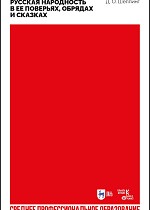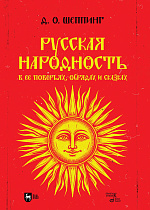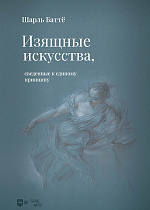Философия искусств - все книги по дисциплине. Издательство Лань
Сохранить список:
Excel
Excel
Закрыть
Выгрузка списка книг доступна только авторизованным пользователям. Авторизоваться
Вниманию читателя представлена широко известная, капитальная работа русского историка, археолога и этнографа Дмитрия Оттовича Шеппинга (1823–1895), посвящённая истории русского фольклора. Основной целью книги является осмысление вопросов, связанных с духовным миросозерцанием русского народа. Автор дает краткий очерк русской мифологии, исследует русские сказки и былины, раскрывает особое значение таких фигур, как Купало и Коляда, Род и Рожаница, Перун, Волос и Иван-царевич в истории русского народа.
Соответствует современным требованиям Федерального государственного образовательного стандарта среднего профессионального образования и профессиональным квалификационным требованиям. Настоящее издание предназначено для студентов и преподавателей средних специальных учебных заведений, специалистов и широкого круга читателей, интересующихся вопросами славянских древностей.
Here’s to your attention the well known, fundamental work by Dmitry Ottovich Shepping (1823–1895), the Russian historian, archaeologist and ethnographer. The book is dedicated to the history of Russian folklore. It is aimed chiefly to understand the issues related to the spiritual worldview of the Russian people. The author gives a brief outline of Russian mythology, examines Russian fairy tales and epics, reveals the special significance of such figures as Kupalo and Koliada, Rod and Rozhanitsa, Perun, Veles and Ivan Tsarevich in the history of the Russian people.
Сorresponds to the modern requirements of the Federal State Educational Standard of Secondary Vocational Education and professional qualification requirements. The current edition is intended for students and teachers of colleges, experts and a wide range of readers interested in issues of Slavic antiquities.
Соответствует современным требованиям Федерального государственного образовательного стандарта среднего профессионального образования и профессиональным квалификационным требованиям. Настоящее издание предназначено для студентов и преподавателей средних специальных учебных заведений, специалистов и широкого круга читателей, интересующихся вопросами славянских древностей.
Here’s to your attention the well known, fundamental work by Dmitry Ottovich Shepping (1823–1895), the Russian historian, archaeologist and ethnographer. The book is dedicated to the history of Russian folklore. It is aimed chiefly to understand the issues related to the spiritual worldview of the Russian people. The author gives a brief outline of Russian mythology, examines Russian fairy tales and epics, reveals the special significance of such figures as Kupalo and Koliada, Rod and Rozhanitsa, Perun, Veles and Ivan Tsarevich in the history of the Russian people.
Сorresponds to the modern requirements of the Federal State Educational Standard of Secondary Vocational Education and professional qualification requirements. The current edition is intended for students and teachers of colleges, experts and a wide range of readers interested in issues of Slavic antiquities.
Вниманию читателя представлена широко известная, капитальная работа русского историка, археолога и этнографа Дмитрия Оттовича Шеппинга (1823–1895), посвящённая истории русского фольклора. Основной целью книги является осмысление вопросов, связанных с духовным миросозерцанием русского народа. Автор дает краткий очерк русской мифологии, исследует русские сказки и былины, раскрывает особое значение таких фигур, как Купало и Коляда, Род и Рожаница, Перун, Волос и Иван-царевич в истории русского народа.
Настоящее издание предназначено для специалистов и широкого круга читателей, интересующихся вопросами славянских древностей.
Here’s to your attention the well known, fundamental work by Dmitry Ottovich Shepping (1823–1895), the Russian historian, archaeologist and ethnographer. The book is dedicated to the history of Russian folklore. It is aimed chiefly to understand the issues related to the spiritual worldview of the Russian people. The author gives a brief outline of Russian mythology, examines Russian fairy tales and epics, reveals the special significance of such figures as Kupalo and Koliada, Rod and Rozhanitsa, Perun, Veles and Ivan Tsarevich in the history of the Russian people.
The current edition is intended for experts and a wide range of readers interested in issues of Slavic antiquities.
Настоящее издание предназначено для специалистов и широкого круга читателей, интересующихся вопросами славянских древностей.
Here’s to your attention the well known, fundamental work by Dmitry Ottovich Shepping (1823–1895), the Russian historian, archaeologist and ethnographer. The book is dedicated to the history of Russian folklore. It is aimed chiefly to understand the issues related to the spiritual worldview of the Russian people. The author gives a brief outline of Russian mythology, examines Russian fairy tales and epics, reveals the special significance of such figures as Kupalo and Koliada, Rod and Rozhanitsa, Perun, Veles and Ivan Tsarevich in the history of the Russian people.
The current edition is intended for experts and a wide range of readers interested in issues of Slavic antiquities.
Шарль Батте (1713–1780) – французский эстетик, аббат, профессор риторики и гуманитарных наук при королевской коллегии в Париже, с 1754 года член Академии надписей, с 1761 член Французской академии. Баттё можно считать основателем французской философии искусства, так как он применил сначала к поэзии, потом к образовательным искусствам принцип Аристотеля: «подражай природе».
Данный трактат является самым полным и всесторонним сочинением по эстетике второй половины XVIII века. Появившийся в этом труде термин «изящные искусства» стал в Европе основным для различения искусства и ремесла (прикладного искусства, искусства вещей). Идеи Шарля Баттё оказали влияние на: Виссариона Белинского, Дени Дидро, Иоганна Винкельмана, Готхольда Лессинга и Николая Чернышевского.
Книга адресована интересующимся философией, эстетикой, искусством и самому широкому кругу читателей.
Charles Batteux (1713–1780) was a French aesthetician, abbot, professor of rhetoric and humanities at the Royal College in Paris, a member of the Academy of Inscriptions since 1754, and a member of the French Academy since 1761. Batteux can be considered the founder of the French philosophy of art, since he applied Aristotle’s principle of “Imitate nature” first to poetry and then to the educational arts.
This treatise (Les beaux arts réduit à un même principe) is the most complete and comprehensive work on aesthetics of the second half of the 18th century. The “fine arts” term that first appeared in this work became the main one in Europe for distinguishing art and craft (applied art, the art of things). Charles Batteux’s ideas influenced V. Belinsky, D. Diderot, J. Winckelmann, G. Lessing, and N. Chernyshevsky.
The book is addressed to anyone interested in philosophy, aesthetics, art and to the widest range of readers.
Данный трактат является самым полным и всесторонним сочинением по эстетике второй половины XVIII века. Появившийся в этом труде термин «изящные искусства» стал в Европе основным для различения искусства и ремесла (прикладного искусства, искусства вещей). Идеи Шарля Баттё оказали влияние на: Виссариона Белинского, Дени Дидро, Иоганна Винкельмана, Готхольда Лессинга и Николая Чернышевского.
Книга адресована интересующимся философией, эстетикой, искусством и самому широкому кругу читателей.
Charles Batteux (1713–1780) was a French aesthetician, abbot, professor of rhetoric and humanities at the Royal College in Paris, a member of the Academy of Inscriptions since 1754, and a member of the French Academy since 1761. Batteux can be considered the founder of the French philosophy of art, since he applied Aristotle’s principle of “Imitate nature” first to poetry and then to the educational arts.
This treatise (Les beaux arts réduit à un même principe) is the most complete and comprehensive work on aesthetics of the second half of the 18th century. The “fine arts” term that first appeared in this work became the main one in Europe for distinguishing art and craft (applied art, the art of things). Charles Batteux’s ideas influenced V. Belinsky, D. Diderot, J. Winckelmann, G. Lessing, and N. Chernyshevsky.
The book is addressed to anyone interested in philosophy, aesthetics, art and to the widest range of readers.
Закрыть
Сообщить о поступлении
Укажите ваш e-mail, и мы пришлем уведомление, как только книга
станет доступна для покупки.




